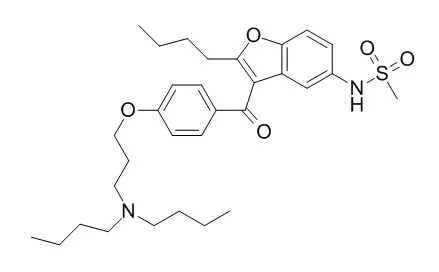| In vivo: |
| Expert Opin Drug Saf. 2015 Jun;14(6):807-13. | | Dronedarone and renal impairment: evaluation of Spanish postmarketing reports and review of literature.[Pubmed: 25967281] | Renal impairment associated with Dronedarone use is hardly known. Our aim is to describe the characteristics of spontaneous reports involving renal adverse reactions with use of Dronedarone.
METHODS AND RESULTS:
In the Spanish Pharmacovigilance database, reports with renal reactions and Dronedarone until May 2014 were retrieved and analyzed. Also, a review of case reports of renal failure and Dronedarone was conducted in MEDLINE.
Dronedarone was found as a suspected drug in 192 reports, 10 (5.2%) of these reports described renal reactions. Renal reactions appeared until 3 months after the onset of Dronedarone treatment. In 5 out of 10 cases, Dronedarone was withdrawn and the patient recovered. The Reporting Odds Ratio was 2.88 [95% CI 1.52 - 5.46; p < 0.05]. Additionally, eight cases were found in the medical literature. In five of them, the patient outcome was described as recovered. One patient had to undergo hemodialysis for the treatment of their renal impairment.
CONCLUSIONS:
The effect of Dronedarone on the renal function is supported by limited information; therefore, the cases from spontaneous reporting system and those from the medical literature could give relevant additional information. Our analysis shows a potential relationship between Dronedarone use and renal impairment. Further studies are needed to confirm these findings. | | Curr Cardiol Rev. 2014 Nov;10(4):303-8. | | The role of dronedarone in the treatment of atrial fibrillation/flutter in the aftermath of PALLAS.[Pubmed: 24821656] | Dronedarone is an amiodarone analog that differs structurally from amiodarone in that the iodine moiety was removed and a methane-sulfonyl group was added. These modifications reduce thyroid and other end-organ adverse effects and makes Dronedarone less lipophilic, with a shorter half-life.
METHODS AND RESULTS:
Dronedarone has been shown to prevent atrial fibrillation/ flutter (AF/AFl) recurrences in several multi-center trials. In addition to its rhythm control properties, Dronedarone has rate control properties. In patients with decompensated heart failure, Dronedarone treatment increased mortality and cardiovascular hospitalizations. When Dronedarone was used in elderly high risk AF/AFl patients, excluding those with advanced heart failure, cardiovascular hospitalizations were significantly reduced. The results of the PALLAS trial suggest that Dronedarone should not be used in the long-term treatment of patients with permanent AF.
CONCLUSIONS:
Post-marketing data have demonstrated rare hepatic toxicity to be associated with Dronedarone use.Updated practice and regulatory guidelines have positioned Dronedarone as a front-line antiarrhythmic in many patients with AF/Fl. However, the drug should not be used in patients with advanced heart failure and in patients who develop permanent AF. | | J Interv Card Electrophysiol. 2015 Mar;42(2):69-76. | | A placebo-controlled, double-blind, randomized, multicenter study to assess the effects of dronedarone 400 mg twice daily for 12 weeks on atrial fibrillation burden in subjects with permanent pacemakers.[Pubmed: 25638303] | Dronedarone is a benzofuran derivative with a pharmacological profile similar to amiodarone but has a more rapid onset of action and a much shorter half-life (13-19 h). Our goal was to evaluate the efficacy of Dronedarone in atrial fibrillation (AF) patients using dual-chamber pacemakers capable of quantifying atrial fibrillation burden.
METHODS AND RESULTS:
Pacemakers were adjusted to optimize AF detection. Patients with AF burden >1% were randomized to Dronedarone 400 mg twice daily (BID) or placebo. Pacemakers were interrogated after 4 and 12 weeks of treatment. The primary endpoint was the change in AF burden from baseline over the 12-week treatment period. Patients with permanent AF, severe/recently decompensated heart failure, and current use of antiarrhythmic drugs were excluded. AF burden was assessed by a core laboratory blinded to treatment assignment. From 285 patients screened, 112 were randomized (mean age 76 years, 60% male, 84% hypertensive, 65% with sick sinus syndrome, 26% with diabetes mellitus type II, 15% with heart failure). Baseline mean (SEM) AF burden was 8.77% (0.16) for placebo and 10.14% (0.17) for Dronedarone. Over the 12-week study period, AF burden compared to baseline decreased by 54.4% (0.22) (P = 0.0009) with Dronedarone and trended higher by 12.8% (0.16) (P = 0.450) with placebo. The absolute change in burden was decreased by 5.5% in the Dronedarone group and increased by 1.1% in the placebo group. Heart rate during AF was reduced to approximately 4 beats/min with Dronedarone (P = 0.285). Adverse events were higher with Dronedarone compared to placebo (65 vs 56%).
CONCLUSIONS:
Dronedarone reduced pacemaker-assessed the relative AF burden compared to baseline and placebo by over 50% during the 12-week observation period. |
|






 Cell. 2018 Jan 11;172(1-2):249-261.e12. doi: 10.1016/j.cell.2017.12.019.IF=36.216(2019)
Cell. 2018 Jan 11;172(1-2):249-261.e12. doi: 10.1016/j.cell.2017.12.019.IF=36.216(2019) Cell Metab. 2020 Mar 3;31(3):534-548.e5. doi: 10.1016/j.cmet.2020.01.002.IF=22.415(2019)
Cell Metab. 2020 Mar 3;31(3):534-548.e5. doi: 10.1016/j.cmet.2020.01.002.IF=22.415(2019) Mol Cell. 2017 Nov 16;68(4):673-685.e6. doi: 10.1016/j.molcel.2017.10.022.IF=14.548(2019)
Mol Cell. 2017 Nov 16;68(4):673-685.e6. doi: 10.1016/j.molcel.2017.10.022.IF=14.548(2019)